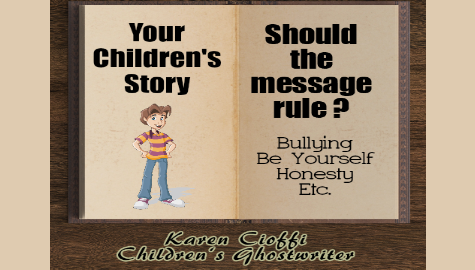I get a lot of clients who want to tell children something through a book.
Like a message in a bottle, these people want to send a message in hopes of teaching the reader something … something the author thinks is important.
People who want to write children’s stories usually want to teach and enlighten children, whether it’s about bullying, being yourself, being kind, or something else.
This is a noble endeavor – the problem, though, is children don’t want to be told what they should or shouldn’t do. They want a fun story that they can get involved in, one they want to turn the pages to find out what happens next, and one they can connect with the main character.
The ‘icing on the cake’ is what the reader takes away from the book, the takeaway value.
So as an author, how do you get your story’s message across without hitting kids over the head?
To start, the story should be about something kids will want to read about. It must have the basic story elements: setting, character, plot, conflict, and point-of-view.
And it should not overtly be about the message.
I recently read a client’s manuscript that flooded the story with the author’s message. Nothing was subtle.
When you have a message that strong in a story, it detracts from the story, from the adventure, from the reader’s enjoyment.
With that said, how do you tone down your message to weave it seamlessly and subtly into your story?
One way, if you’re writing a story because of a message you have, is to think of a scenario where your message could play out.
In this scenario, your message or moral takeaway is about doing the right thing, even if tempted.
Suppose the story is about Sammy, a kid who’s basically honest.
Sammy and his friends find a bag of money on a shelf in the garage of an elderly neighbor they’re cleaning the garage for.
It’s a lot of money, and Josh wants to split the money between himself, Sammy, and another friend, rationalizing that the neighbor probably didn’t even remember he had the money there.
After thinking about it for a minute or so, Sammy finally tells Josh to put the money back.
A few seconds later, the elderly neighbor walks into the garage.
While this is just the basics of a possible story, you can see that Sammy was tempted. He probably thought all sorts of things before finally realizing it wasn’t right.
Nowhere in the story should it say, ‘Crime doesn’t pay.’ Nor should it overtly tell the reader that if the boys had decided to keep the money, the elderly neighbor would have walked in on them as they were dividing the money.
Let the reader come up with their own conclusions.
If the story is written right, the reader will get the takeaway value without realizing they are … without the author hitting them over the head with it.
A story that takes the protagonist on a journey should result in him growing in some way.
Using Sammy above as an example, maybe he wasn’t sure of what he’d do under those circumstances. Maybe he thought about being dishonest in the past. Maybe he struggled with his honesty in little things.
He chose the right path and learned something about himself. He was an honest kid.
Again, your young reader wants to be engaged, first and foremost. They want to go on an engaging journey – they don’t want to be ‘messaged.’
Sources:
https://www.helpingwritersbecomeauthors.com/storys-theme-2/#
https://www.dailywritingtips.com/dont-overload-your-readers/
http://www.literacyideas.com/teaching-story-elements/

I’m a working children’s ghostwriter, rewriter, editor, and coach. I can help turn your story into a book you’ll be proud to be the author of, one that’s publishable and marketable.
OTHER HELP I OFFER:
HOW TO WRITE A CHILDREN’S FICTION BOOK
A DIY book to help you write your own children’s book.
PICTURE BOOK, CHAPTER BOOK, MIDDLE GRADE COACHING
Four to ten-week coaching programs.
WRITERS ON THE MOVE SELF-PUBLISHING HELP
Self-publishing help for children’s authors.
Creating An Author Online Platform
Step-by-step with a former WOW! Women on Writing author online platform instructor.
You can contact me at: kcioffiventrice@gmail.com. Or give me a call at 347—834—6700. (Please leave a message- I’ll get back to you as soon as I can.)
The Pros and Cons of Publishing with a Small Publisher
Save Writing Time: Try an Outline-Sketch
4 Reasons Why Self-Publishing Your Children’s Book May Be Your Best Option



1 thought on “Should Your Message Rule Your Children’s Story?”